by Brion Hurley and Greg Weisenborn
For the 7th year in a row, the board of the Sustainable Development Division has organized a volunteer service project with a local nonprofit prior to the start of the IISE Annual Conference, held for the 2nd year in a row in Orlando.
As a reminder, here are the recaps of our previous service projects.
- 2013 – Beach cleanup (San Juan)
- 2014 – Le Chainon (Montreal)
- 2015 – Hands on Nashville Urban Farm (Nashville)
- 2016 – Habitat for Humanity ReStore (Anaheim)
- 2017 – Pittsburgh Food Bank (Pittsburgh)
- 2018 – Orlando Habitat for Humanity ReStore
Due to popularity of this event, we added a 2nd nonprofit this year to handle the demand. Previous years, we have turned away potential volunteers.
The first organization selected was Habitat for Humanity, due to our connections from the 2018 event. However, the ReStore had been closed down since last year, so we decided to help out the home building side of Habitat.
The second organization selected was Rise Against Hunger. We learned about them through their submission to the Excellence in Sustainable Development Award, and they were named the inaugural winner in 2019. Read more about their accomplishments and recognition.
The purpose of our volunteering is not just to help out the organization, but to provide feedback afterwards on the process improvement opportunities we observed in order to improve their operations and volunteer experience.

To learn more about them, visit their website at https://HabitatOrlandoOsceola.org, or watch the video below to learn more about H4H’s mission to provide affordable housing…
Volunteers left from the hotel on Saturday morning headed for Apopka, FL, an Orlando suburb. Within a large metro area such as Orlando, there are multiple Habitat for Humanity affiliates. One problem encountered immediately was some confusion about the job site location. Different H4H affiliates might be operating in the same geographic region, and our volunteer team originally stopped at the wrong house, run by a different affiliate.
With our division’s ongoing engagements with Habitat at different IISE Annual Conference locations, we continue to learn more about the nationwide organization. Different Habitat affiliates focus on different regional activities, playing to their strengths, and regional needs and opportunities.
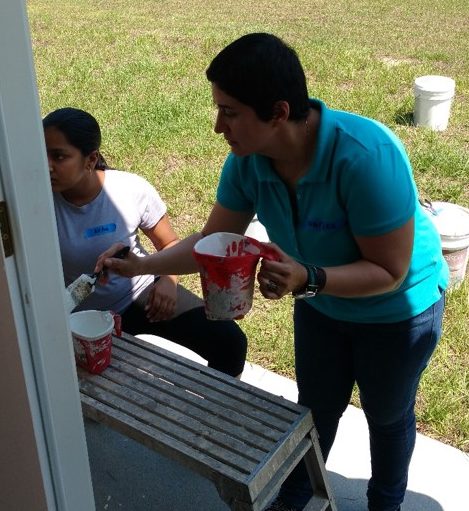
The affiliate we worked with prefers to focus on building large 30-50 house development initiatives. They operate with full-time construction professionals leading teams of volunteers. With the large number of volunteers, they have personnel dedicated to volunteer experience and coordination.
New homeowners must work about 200 volunteer hours as part of their contribution to purchasing a new Habitat home. The financial model for each new homeowner is complex with a variety of sources required. We worked side-by-side with future homeowners and their friends, as well as with college and high-school students who had service-hours goals as part of either their personal dedication or requirements for academic programs. For example, the state of Florida Bright Futures scholarship program requires that high-school students complete service hours.

On-site, safety was key. The site manager “trained us up” on job-site safety basics, including awareness of heat and humidity in Orlando. He quickly identified individual volunteers’ personal abilities, strengths, and interests.
Our team worked on two different houses on the same block. One house was prepping for final inspection and “closing” at the end of the weekend, and both were at the “finishing” stage, so much of our work was indoors. Hopefully, our innate ISE mindset (poka-yoke, conservation of resources, “measure-twice-cut-once”…) rubbed-off on the students who were working with us side-by-side. We had a couple of good conversations with students who showed some polite interest in our willingness to share information about industrial engineering.
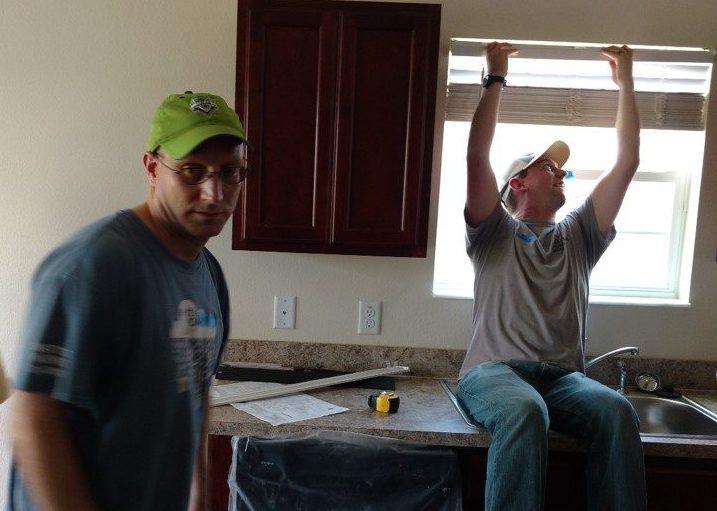
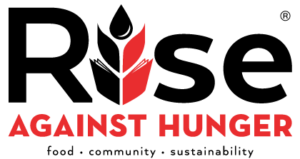
To learn more about them, visit their website at https://www.riseagainsthunger.org/, or watch the video below to learn more about RAH’s mission of achieving zero hunger…
Jason Haulbrook greeted us when we arrived with our oversized bus, and gave us a quick tour of the space. Immediately, we were impressed with the organization and cleanliness. There was clear evidence of their workplace organization activities, which was a significant part of their documented improvements.
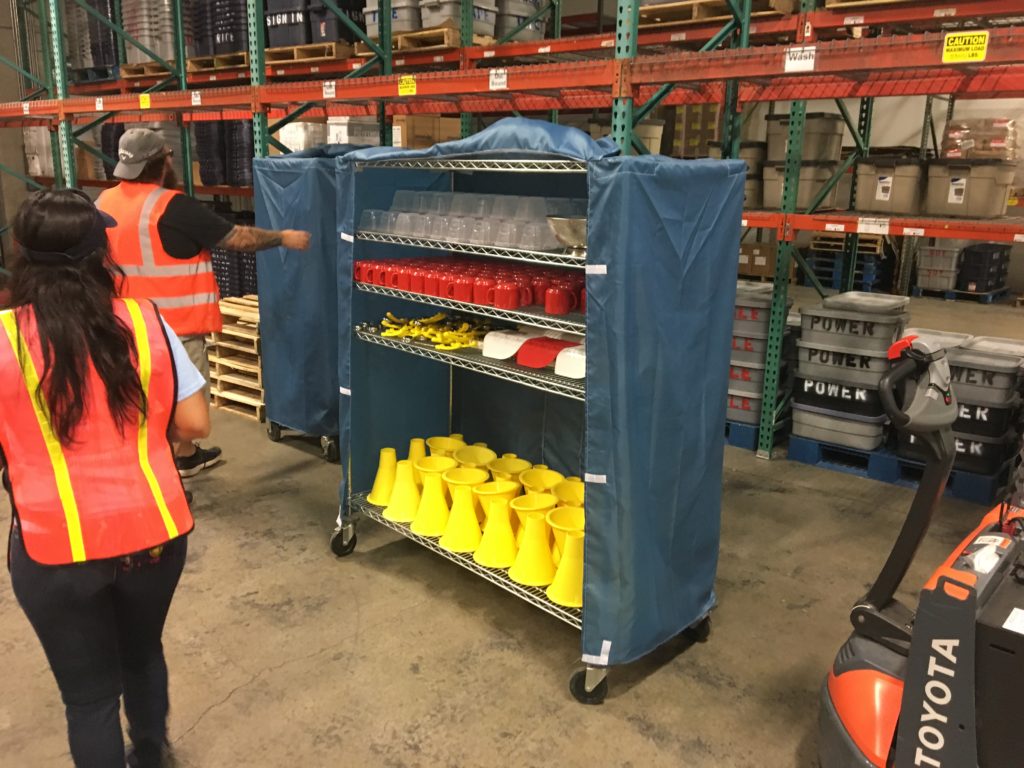
The team split into two groups: One group to wash the supplies from a recent event, and another group helped get the dried supplies organized for an upcoming event in Jacksonville.
Washing Stations
There were three stations and three sinks for each station. We staffed one person at each sink, and there was a fourth person to put them away on the rack.
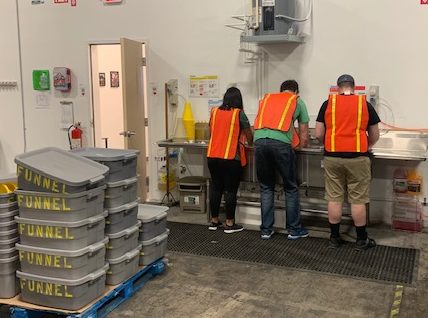
After observing how the next process would put the utensils and supplies away, we made some changes to how we intended to stack the items on the drying rack.
One of our process requirements was to leave the dishes in the final sink rinse for at least 15 seconds. Without a clock or alarm to control that, we setup a phone with a timer, and controlled the workflow. If we overloaded the last sink station, it might be confusing to know which items were in there a long time, and which ones were just added. Therefore, we setup a simple kanban system to have one set of dishes being dried, one set sitting in the sink, and one ready to be added. That station was usually the bottleneck, so we controlled the workflow at that stage. This helped us avoid mixing up the dishes, and ensuring the dishes received enough soaking time.
Label study
The second group finished their put away work early, so they got started on adding labels to empty meal packages. Each package needs to be closely controlled in case there is food contamination or a bad batch of supplies.
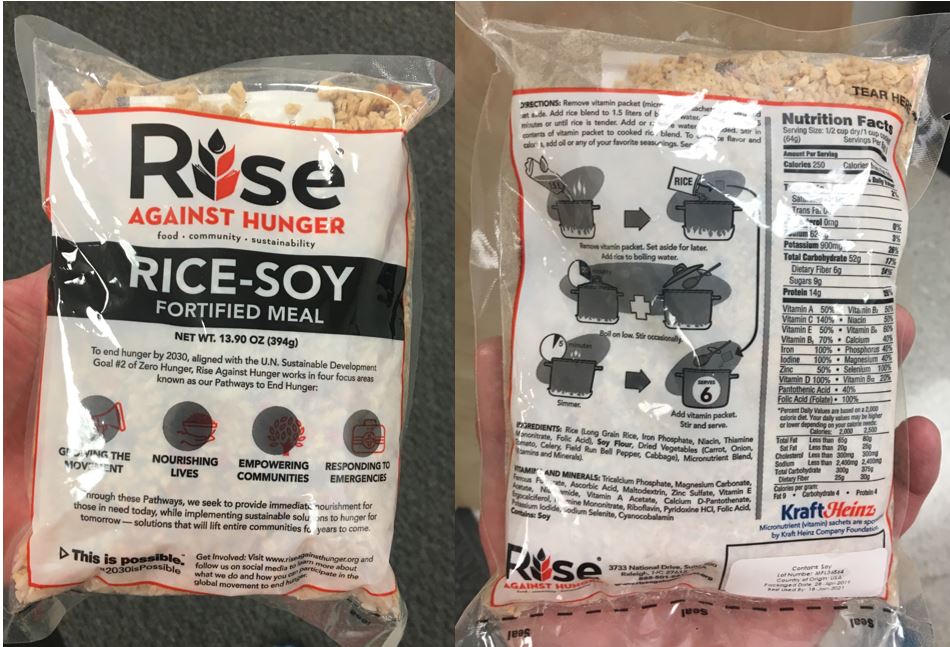
Because we can’t avoid collecting data, one question we tried to answer was which method of applying the labels would be more efficient, using a rubber band and flipping through the stack, or flipping over each package upon completion.

Using the rubber band (flipping like a book), it took 130 seconds for 22 labels to be applied, for an average of 5.9 seconds per label.
Without the rubber band (flipping each package over), it took 638 seconds for 100 labels, for an average of 6.4 seconds per label.
If they go with the rubber band method (based on our small sample study), they could potentially save about 8 minutes for every 1,000 labels applied.
However, efficiency is not the most important metric for a nonprofit. They also want to balance efficiency with the volunteer experience. In our example above, if the faster method was less enjoyable for the volunteer, they would opt for the slower method every time.
We provided about 20 improvement ideas to Jason, based on our experience as a volunteer that day, and our process efficiency experience at work.
At the end of the day, we tested out the meal. It was good and nutritious, but a little bland in flavor, but Jason explained that it was on purpose. Those receiving the meals may not have the stomach to handle anything to flavorful or spicy.

A special thank you to all our volunteers:
Habitat for Humanity: Greg Weisenborn, Alex Newman, Kirk Foster, Narjes Sadeghiamirshah, Dan Castle.
Rise Against Hunger: Maria Carolina Diaz, John Corliss, Dustin Diep, Abhishek Taneja, Mizelle Honilla, Caroline Krejci, and Nicholas Eichner.
If you’d like to join us at our next volunteer service project, our next one will be in New Orleans on May 30, 2020. We are currently working to find a nonprofit organization in the area that would like our assistance and recommendations. Contact me if you would like to be involved, or know an organization we can connect with.
Check the IISE Annual Conference website for announcements around February or March.


 If you are interested in the Sustainable Development division of the Institute of Industrial and Systems Engineers (IISE),
If you are interested in the Sustainable Development division of the Institute of Industrial and Systems Engineers (IISE),
One comment